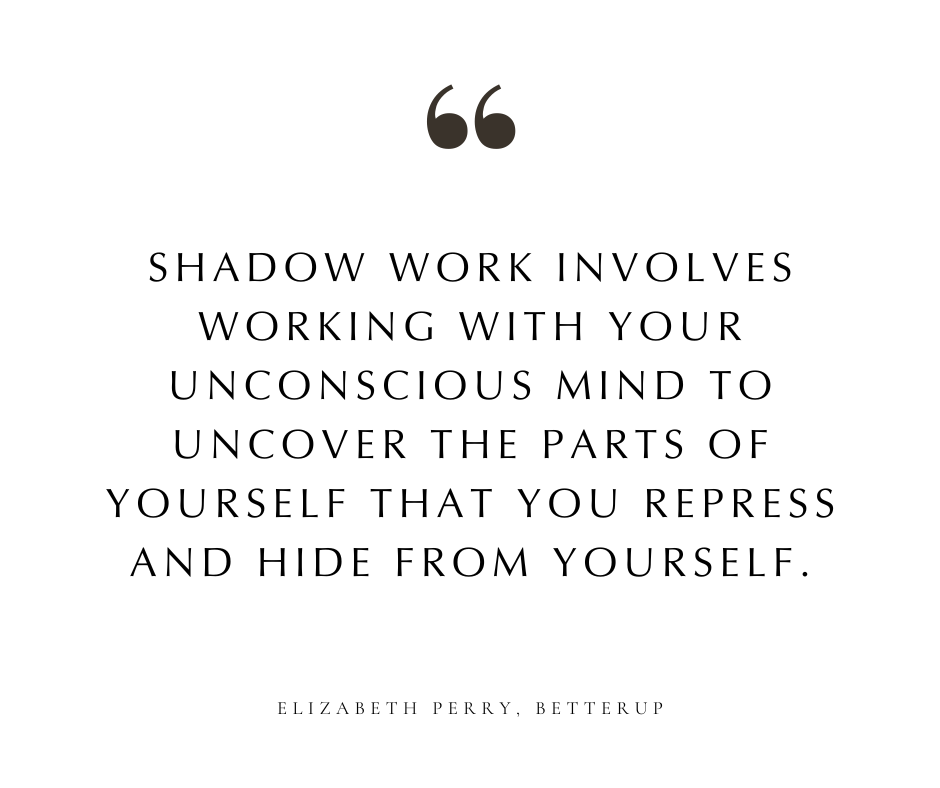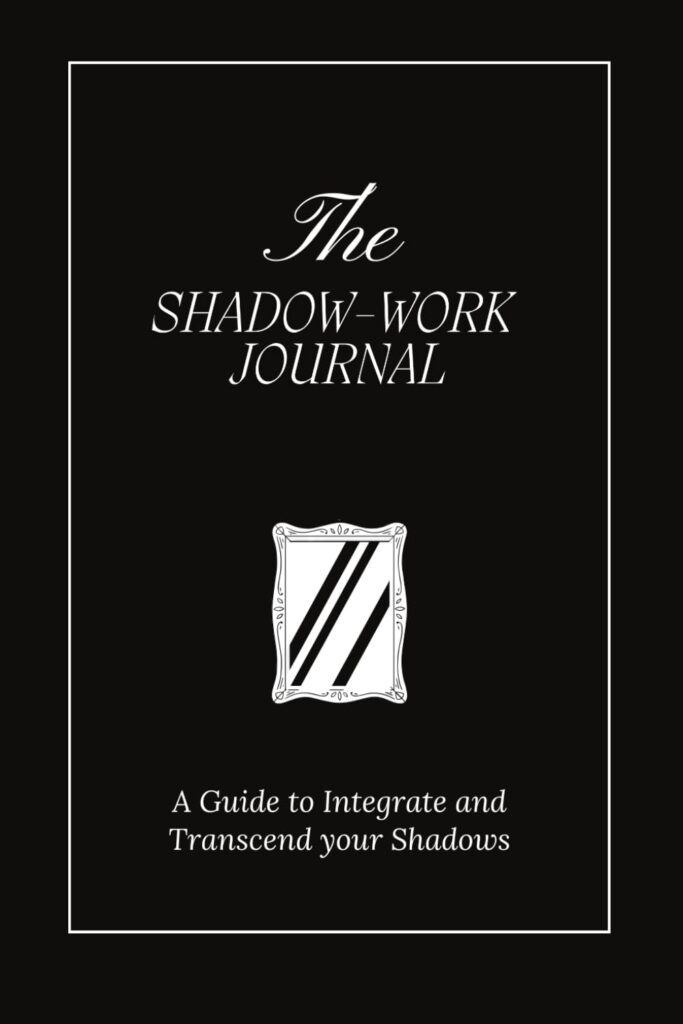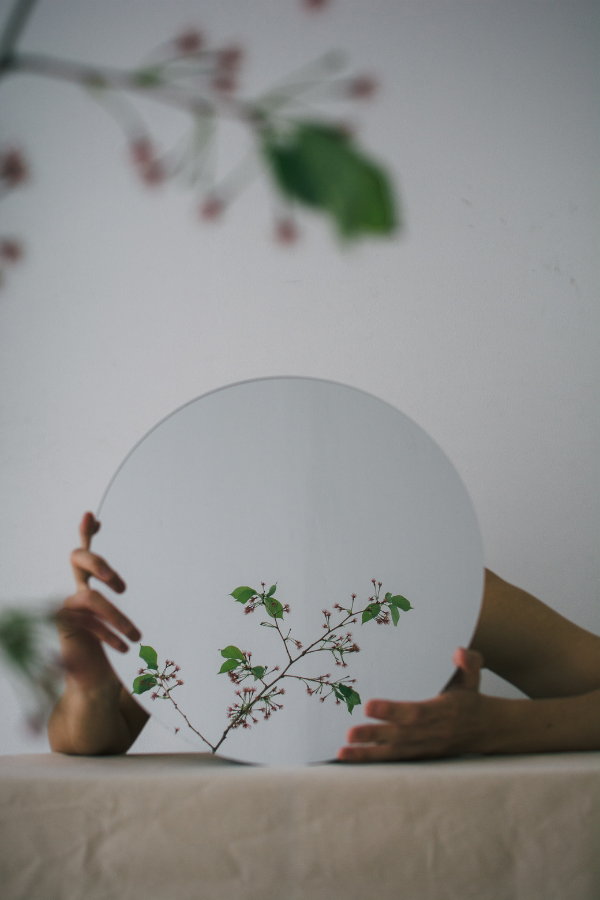

What is Shadow Work Journaling, and How Can I Start My Own?
Summary
Reflection Questions
Journal Prompt
Shadow work in psychology refers to the process of exploring the unconscious aspects of the self that are often hidden or suppressed. Originating from the work of Carl Jung, it involves acknowledging, understanding, and integrating these repressed or ignored parts of our personality into our conscious awareness. This process helps individuals achieve greater self-awareness, psychological balance, and healing by confronting and reconciling with their inner shadows, which can include negative emotions, past traumas, and unacknowledged aspects of themselves. Today, many women examine their shadow selves in an attempt to better understand themselves, get un stuck, heal their inner child, improve their mental health, and unlock their true potential through their own shadow work journal. As always, we encourage women to seek guidance from a licensed therapist if using a shadow work journal to tackle complex emotional and mental health issues as part of their journeys toward self discovery and personal growth. Read on to learn more about what a shadow work journal includes, how it might help you, and which journal prompts you can start with.


TL;DR
Shadow work journaling is an introspective practice that encourages individuals to explore and integrate the hidden parts of their psyche. This type of journaling is rooted in the psychological concept of the “shadow self,” which includes all the parts of ourselves we’ve denied or suppressed.
For women in creative professions, shadow work journaling can unlock a deeper well of creativity by helping them confront hidden fears, desires, and past experiences that may be influencing their work. To start, it involves setting clear intentions, creating a safe and private space for reflection, engaging in honest and non-judgmental self-exploration, and considering professional guidance if necessary.
By incorporating this practice into their daily routine and creative process, women can harness their full potential, leading to personal growth and more authentic and profound creative expression.
What Exactly is Shadow Work Journaling?


Shadow work is a profound journey into the depths of the self, an exploration that unveils the concealed parts of our being. Originating from analytical psychology, shadow work encourages us to engage with the aspects of our personality we often sideline or suppress. This venture is not for the faint-hearted—it requires courage, curiosity, and a relentless pursuit of self-awareness.
The origins of shadow work trace back to the luminary thinker, Carl Jung, who first introduced the concept of the “shadow” as an integral part of the human psyche. It encompasses all that we are not consciously aware of within ourselves. Historically, this exploration has been a cornerstone for those seeking to understand the full spectrum of their identity, urging individuals to reconcile with their innermost fears, desires, and forgotten parts to achieve wholeness and harmony.
More on the Psychological Basis of Shadow Work
At the heart of shadow work lies Carl Jung’s groundbreaking concept of the shadow self, a foundational pillar in the edifice of analytical psychology. Jung posited that our shadow embodies the repressed, ignored, or denied facets of our personality—traits that society often deems unacceptable or undesirable. This shadow self, while concealed, exerts a profound influence on our behaviors, relationships, and life choices.
Engaging with our shadow is a daring act of self-discovery that reveals the duality of our nature, encouraging us to embrace our complexity. The psychological basis of shadow work offers a lens through which we can navigate the murky waters of the unconscious mind, transforming our shadows into sources of strength, creativity, and personal growth. It is a call to embark on a journey of reconciliation and integration, where every hidden aspect of ourselves is acknowledged and honored.
The Role of Journaling in Shadow Work


Journaling serves as a powerful conduit for shadow work, offering a sanctuary where our innermost thoughts, fears, and desires can be expressed freely and without judgment. This reflective practice invites us to dialogue with our shadow, to pen down the whispers of our hidden selves, and to confront the narratives we shy away from. Through the act of writing, we externalize our internal conflicts, making them tangible and easier to understand.
Journaling in the context of shadow work is not merely a record of daily events; it is a profound tool for self-inquiry, a mirror reflecting the multifaceted dimensions of our psyche. It encourages a deep dive into the subconscious, facilitating a process of healing and transformation. As we articulate the unsaid and explore the unexplored, journaling becomes a key ally in our quest for authenticity and self-acceptance.
Fuel your creative fire & be a part of a supportive community that values how you love to live.
subscribe to our newsletter
*please check your Spam folder for the latest DesignDash Magazine issue immediately after subscription


Examining the Recent Popularity of the Viral Shadow Work Journal
The recent surge in the popularity of the shadow work journal is a testament to the collective yearning for deeper self-understanding and authentic living. This viral phenomenon has captured the imagination of many, becoming a vibrant movement that transcends boundaries. The allure of the shadow work journal lies in its promise of liberation with each prompt—from societal expectations, from self-imposed limitations, and from the shadows that haunt our subconscious.
As women across the globe share their experiences and insights, the practice of journaling for shadow work has evolved into a dynamic community of seekers, each on their own path yet connected by the universal quest for self-discovery. This renaissance of interest in the hidden aspects of the self not only highlights the timeless relevance of Jung’s concepts but also underscores the transformative power of introspection and the written word in the journey towards a more integrated and authentic self.
The Shadow Work Journal by Keila Shaheen


One of the women responsible for its resurgence is Keila Shaheen, author of the bestselling self-help book The Shadow Work Journal: A Guide to Integrate and Transcend your Shadows. Originally published in 2021, this book presents a comprehensive approach to engaging with one’s shadow self through journaling. This book is designed as a practical tool for personal transformation, providing readers with a structured pathway to explore and integrate the hidden aspects of their psyche. The updated and expanded version, published on May 14, 2023, elaborates upon the original with updated and additional content to deepen the shadow work experience.
The journal includes a variety of meaningful affirmations, profound journaling prompts, exercises, and tools aimed at facilitating deep self-exploration. Readers are guided through processes such as wound mapping, breathwork, visualization, and EFT tapping, alongside reflective journaling prompts that cover a broad spectrum of topics including inner-child work, anger, anxiety, and self-perception. These exercises are designed to help individuals confront and understand their fears, insecurities, and negative behavior patterns, fostering a journey towards becoming a more integrated and authentic version of themselves.
Notably, the journal emphasizes the benefits of shadow work, highlighting improvements in personal relationships, healing generational trauma, setting personal boundaries, fostering self-compassion, and gaining clarity and awareness about oneself and the surrounding world. It serves as both a guide and a companion for those looking to embark on a journey of self-discovery and healing, promoting personal growth and transformation.
The Shadow Work Journal stands out for its hands-on approach, providing readers with a “Personal Declaration of Intent” and “Get to the root of your shadow” easy to use pages, which are specifically designed to address shadows as they appear. This approach ensures that the journal is not only a tool for reflection but also an active participant in the reader’s journey towards self-awareness and self-acceptance.
Exploring the Benefits of Shadow Work Journaling for Women in Creative Fields
Enhancing Creativity by Embracing All Parts of the Self


Shadow work journaling opens the door to a deeper understanding and acceptance of oneself, laying a fertile ground for creativity to flourish. By engaging with both the light and dark aspects of their personality, women can tap into an expansive reservoir of inspiration and ideas.
This holistic embrace of the self fosters an environment where creativity is not just an output but a reflection of one’s entire being. It encourages an exploration beyond conventional boundaries, leading to innovative thoughts and groundbreaking work. Embracing the full spectrum of one’s experiences and emotions can lead to a more nuanced and rich creative expression, making the creative process a deeply personal and transformative journey.
Overcoming Creative Blocks and Fears


Creative blocks and fears often stem from unaddressed shadows—those repressed parts of our psyche that we shy away from. Shadow work journaling acts as a key to unlock these hidden chambers, allowing for a confrontation and reconciliation with one’s fears and insecurities. This process not only clears the path obstructed by creative blocks but also transforms fear into a powerful ally.
By facing their innermost fears head-on, individuals can dismantle the barriers to their creative flow, paving the way for a renewed sense of freedom and possibility in their creative endeavors. This liberation from fear inspires boldness and a willingness to experiment, which are crucial for creative innovation and expression.
Improving Emotional Intelligence and Resilience


Shadow work journaling cultivates a profound self-awareness, enhancing emotional intelligence by enabling individuals to recognize, understand, and manage their emotions more effectively. This heightened awareness contributes to a deeper empathy and connection with others, enriching the emotional depth of creative work. Moreover, the process of engaging with one’s shadow builds resilience, as individuals learn to navigate through emotional challenges and uncertainties. This resilience is invaluable in the often tumultuous journey of creative professions, providing a steady foundation from which to approach both personal and professional challenges with grace and adaptability.
Strengthening Authenticity in Creative Expression


Authenticity in creative expression is the hallmark of truly impactful work. Shadow work journaling fosters this authenticity by encouraging individuals to delve into the depths of their identity, bringing forth a voice that is uniquely their own. As women in creative fields reconcile with their shadows, they unlock a more authentic mode of expression that resonates deeply with audiences.
This authenticity not only distinguishes their work in a crowded field but also establishes a genuine connection with the viewer or reader. Authentic creative work, imbued with the truth of the creator’s experience, stands out for its ability to touch, inspire, and provoke thought, creating a lasting impact that transcends the superficial layers of conventional creativity.
How to Start Shadow Work Journaling


Starting a shadow work journal is part of your ongoing journey towards embracing your full self, unlocking the doors to deeper creativity, emotional resilience, and authenticity. With intention, privacy, honesty, and possibly professional guidance, you’re well on your way to uncovering the treasures hidden in the shadows. Here’s how to begin this transformative practice.
Setting Intentions for Your Shadow Work Practice


Initiating your shadow work journaling journey with clear intentions is pivotal. It’s about defining what you hope to uncover, heal, or achieve through this introspective practice. Whether you’re seeking to understand hidden parts of your psyche, heal emotional wounds, or simply gain a deeper insight into your behaviors and patterns, setting intentions acts as a guiding light. This deliberate act of intentionality ensures your efforts are aligned with your personal growth goals, making the process both meaningful and directed. Remember, the clarity of your intentions directly influences the depth and focus of your self-exploration.
Creating a Safe and Private Space for Journaling
Crafting a sanctuary for your shadow work journaling is crucial. This space should be both physically comfortable and emotionally secure, where privacy is paramount, and interruption is minimal. It could be a cozy corner of your home adorned with items that evoke serenity and inspiration or a secluded spot in nature. The key is to choose a setting that resonates with your soul, one that invites openness and vulnerability. In this private haven, you are free to express your deepest thoughts and feelings without fear of judgment, creating an atmosphere conducive to profound introspection and healing.
Being Honest With Yourself and Engaging in Non-judgmental Self-reflection


The essence of shadow work journaling lies in raw, honest self-reflection. Approach your journaling with an open heart, ready to embrace whatever surfaces, without self-criticism or judgment. Acknowledge that this process is about uncovering the truth of your inner world, which requires courage and compassion. To foster this non-judgmental environment, remind yourself that all emotions and thoughts are valid and serve as gateways to deeper understanding. Keep your journal handy and encourage a dialogue with yourself that is kind, curious, and accepting, knowing that self-awareness is the first step towards transformation.
Working with a Therapist if Necessary
While shadow work journaling can be a profoundly personal and rewarding journey, it may also unearth deep-seated emotions and memories that are challenging to navigate alone. In such instances, seeking the guidance of a therapist can be invaluable. A professional trained in cognitive behavioral therapy can provide the support, tools, and perspective needed to safely explore and integrate these shadow aspects. They can help you set personal boundaries, understand the nuances of your discoveries, offer strategies for healing, and support you in translating insights into meaningful change. Remember, seeking help is a sign of strength and a commitment to your mental health and well-being.
Shadow Work Journal Prompts to Get You Started


Starting a shadow work journal is a profound step towards self-discovery and personal growth. Below are thoughtfully crafted prompts designed to guide you through the exploration of your inner landscape, uncovering hidden fears and desires, delving into past experiences, and reconciling with parts of yourself that you’ve perhaps ignored or suppressed.
These prompts are designed not just to probe and question but to illuminate and guide your journey towards greater self-awareness and integration. Through this introspective practice, you’ll uncover the rich tapestry of your inner world, fostering a deeper connection with yourself and enhancing your creative expression. Remember, the path to discovery is not always straight; it weaves through the shadows to bring you closer to your authentic self, unlocking new realms of possibility and inspiration along the way.
Prompts for Uncovering Hidden Fears and Desires
What am I most afraid to write about and why? This prompt invites you to confront the topics you avoid, providing insights into your deepest fears and unacknowledged desires.
Which of my desires do I judge the most and what does that judgment reveal about my values and beliefs? Explore the desires you’ve deemed off-limits or shameful to better understand the conflicts between your inner wants and your external values.
If I had no fear of judgment, what would I pursue today? Reflect on how the fear of others’ opinions holds you back from pursuing your true passions and interests.
Prompts for Exploring Past Experiences and Their Impact on Your Creative Work
What past experience has significantly shaped my view of creativity? Delve into your history to uncover events that have influenced how you view and engage with your creative side.
How do my most impactful memories manifest in my creative work? Consider the ways in which your significant life moments find expression in your art, writing, or other creative endeavors.
Which childhood dreams or interests have I left behind, and how can they inspire my current creative projects? Reconnect with your younger self’s aspirations to find fresh inspiration and direction in your creative pursuits.
Prompts for Reconciling with Parts of Yourself You’ve Ignored or Suppressed
What qualities in others trigger a strong reaction in me and what does this say about the parts of myself I don’t fully accept? This prompt encourages you to reflect on your projections and how they mirror aspects of yourself you’ve yet to embrace.
In what situations do I find myself wearing a ‘mask,’ and what am I hiding? Identify moments when you feel the need to conceal your true self, exploring the fears and insecurities that prompt these actions.
What am I most critical of in myself, and how can I offer compassion and understanding to these parts? Turn a critical eye into a compassionate one by understanding and accepting your perceived flaws or weaknesses.
Incorporating Shadow Work Journaling into Your Creative Process


Begin each day with a moment of introspection, setting aside time for journaling that feels sacred and undisturbed. This could be early in the morning when the world is still quiet, or late at night when the day’s distractions have faded away. Consider rituals that signal the start of this introspective time—lighting a candle, brewing a cup of tea, or sitting in a designated space that feels inviting and comfortable. This daily commitment becomes a ritual, a dedicated time to explore the depths of your subconscious, unlocking new layers of creativity and understanding.
Using Insights from Shadow Work to Fuel Your Creative Projects
The revelations unearthed through shadow work journaling hold immense power to fuel your creative projects. Insights into hidden fears, desires, and suppressed parts of your psyche can become the foundation for profound creative expression. Use these discoveries to inform your work, allowing them to shape narratives, themes, and aesthetics. For instance, if your journaling uncovers a long-held fear of rejection, explore this theme in your next project, perhaps through a series of paintings, a novel, or a musical composition. Let the raw, unfiltered emotions guide your creative process, transforming personal insights into universal truths that resonate with others.
By integrating shadow work journaling into your creative process, you not only enhance your artistic output but also embark on a journey of personal growth and self-discovery. This practice encourages a holistic approach to creativity, where the artist does not shy away from the depths of their being but instead, dives in with courage, using every discovery as a stepping stone towards greater authenticity and expression.
Final Thoughts on Creating a Shadow Work Journal to Better Understand Yourself


Shadow work journaling allows for a unique exploration of the hidden corners of the psyche, unveiling fears, desires, and past experiences that shape our creative vision and output. By embracing shadow work as a regular practice, you unlock the potential for profound personal and professional growth, leveraging the richness of your inner world to fuel your creative endeavors. This journey not only fosters a deeper connection with yourself but also enhances the authenticity and depth of your creative work. It could help you develop a more fulfilling life over time.
Let us know how you approach shadow work journaling in the comments below!
Design Dash
Join us in designing a life you love.
-
10 Iconic Buildings from the Gothic Architecture Movement
Explore 10 of the most iconic Gothic buildings that define medieval Gothic architecture—from Notre-Dame de Paris to Cologne Cathedral.
-
Zen Design in Interior Design
LIKE 0 LEAVE COMMENT 0 11 min read SummaryReflection QuestionsJournal PromptEver walked into a room and instantly felt your shoulders drop, your breath slow, and your mind clear? That, my friends, is the magic of Zen design in interior spaces. It’s like your home is giving you a warm, calming hug – minus the awkward…
-
Nutritious Habits for Female Entrepreneurs
LIKE 0 LEAVE COMMENT 0 8 min read Summary Reflection Questions Journal Prompt Ladies, let’s talk about the elephant in the room – or should I say, the growling stomach in the boardroom? As a fellow female entrepreneur, I’ve been there: scarfing down a sad desk salad while juggling calls, or worse, forgetting to eat…
-
Navigating the Social Scene as a Busy Female Entrepreneur
LIKE 0 LEAVE COMMENT 0 11 min read Summary Reflection Questions Journal Prompt Hey there, fellow boss babes! It’s your girl, here, ready to dive into the wild world of socializing as a busy female entrepreneur. Juggling a thriving business with a vibrant social life can feel about as easy as nailing jello to a…
-
Exploring the Role of Technology in Interior Design
LIKE 0 LEAVE COMMENT 0 11 min read Summary Reflection Questions Journal Prompt The world of interior design is getting a serious tech makeover, and it’s absolutely fabulous. Gone are the days of squinting at fabric swatches and trying to envision how that chaise lounge will look in your living room. Technology trends in interior…
-
Custom or Ready-Made? How to Select Furniture for Residential and Commercial Spaces
Should you choose custom or ready-made furniture? This guide breaks down cost, lead time, and design considerations to help you decide.








